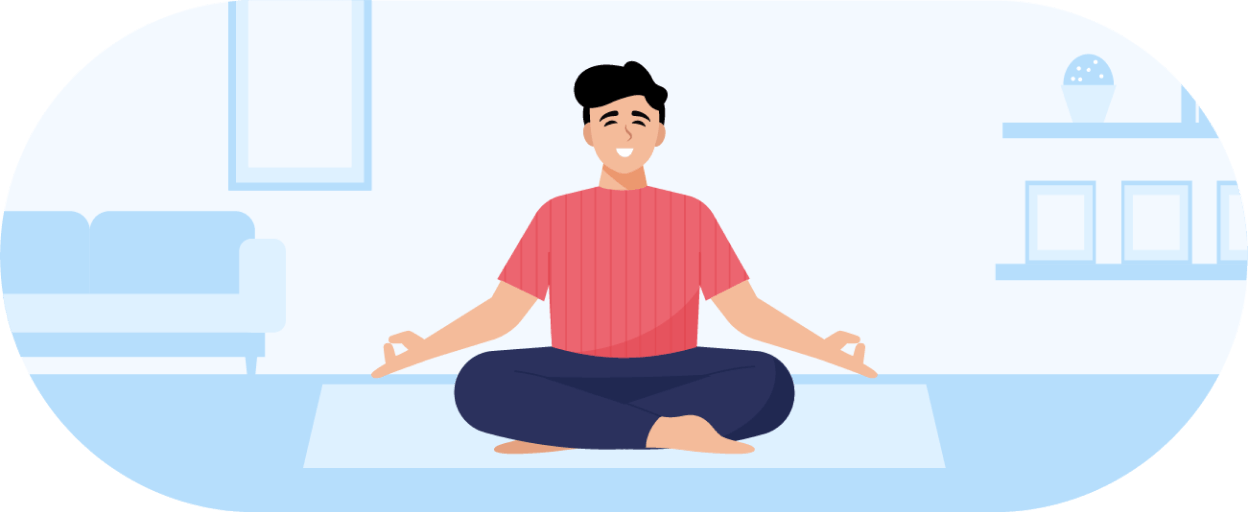
Regular yoga practice can contribute to the health and wellness of people of all age groups. Several yoga asanas can be done in seated positions, which improve movement, breathing, relaxation, and flexibility. However, you must have full details and guidance before practising any poses.
Practising yoga asanas regularly is a journey towards total wellness, whether for back pain relief, improving strength and flexibility, reducing stress, or enhancing heart function.
Sitting yoga is performed in a seated position; these poses are known best for improving body flexibility besides reducing your stress, and anxiety. All these yoga asanas should be done for around one minute, repeating as per your comfort level. However, if you find any posture uncomfortable, you must stop and take expert guidance.
The following sitting yoga posture examples are illustrative; please check the complete procedures before practising to get the full yoga advantage.
- Shishuasana
You sit on your heels with your knee bent and stretch your hands forward.
• Excellent stress and fatigue buster
- Paschimottansana
With the legs stretched straight forward, you bend to touch the feet with both hands.
• Improves hamstring and strengthens pelvic regions.
- Marjariasana
Position your hands perpendicular to the ground, shoulders in line, and knees on the floor. Inhale while stretching your neck and while exhaling, drop your chin while arching your back.
• Improves spine flexibility
- Ustrasana
Kneel with your hands on your hips and arch backwards with your hands on your ankles, one by one.
• Improves digestion
- Janu Sirsasana
- Badhakonasana
You begin by sitting on the floor and extending your legs. Bend your right knee and move the right foot sole close to the left thigh. Exhale and lower your torso slowly, trying to touch your left foot; repeat by switching sides.
- Exercises the neck and shoulders
Bend your knees in a sitting position, pull your feet towards the pelvis, with the soles touching each other, and hold both feet with your hands.
• Improves hip flexibility
- Ardha Matsyendrasana
Begin by sitting on bent knees with the right leg over the left knee. Put your left hand on the right ankle and the right hand on the ground behind. Next, twist the waist, shoulders, and neck.
• Increases oxygen supply to the lungs
- Virasana
Sit down with your knees/ankles in line, your legs and soles facing upwards, your hips placed between your soles, and your palms on your thighs; breathe slowly.
• helps manage blood pressure and asthma
- Sukhasana
Sit in a cross-legged position with the left leg under the right thigh and the right leg under the left thigh. Keep your back and shoulders straight, and breathe normally. Inter-change legs after five minutes.
• Improves spinal health
- Chakki Chalanasana
Start with your feet stretched apart and pull forward your clasped hands. Then, move the upper portion of your body in an imaginary circle from the left to the right and then reverse.
• Tones up back
- Dandasana
Stretch your legs in front, keeping your feet together; then, place your arms next to the hips on either side of your body while sitting upright. Deep breathe.
• boosts respiratory system
- Padmasana
Sit with both knees crossed over the thighs, the right foot over the left thigh and the left one over the right thigh. Your knees should rest on your hands.
• Improves concentration
- Vajrasana
You should be in a kneeling position, knees/ankles together, soles of your feet facing upwards, hips resting on your soles, and head looking forward.
• Helps in blood sugar management
- Hanumasana
Sit kneeling with your right legs straight and your heels touching the floor. Stretch your left leg backwards and prop it on your fingertips. Hold on for a few seconds, then repeat with your left leg.
• Keeps the heart agile
- Savasana
Lie flat on your back with your face up. Separate your legs and arms and place them by your body’s side, palms facing up. Keep both eyes closed and relax; take a few deep breaths.
• Releases tension
Health insurance with Yoga Coverage
Adding a yoga regime to your lifestyle can significantly contribute to your physical and mental wellness. Health insurance is another critical aspect of health protection. With the cost of medical treatment rising rapidly, health plans provide crucial financial support in moments of crisis.
Besides some regular plans offering yoga coverage as a wellness benefit, you can also choose Ayush health insurance. ‘Ayush’ refers to alternative medical disciplines, namely Ayurveda, Yoga, Naturopathy, Unani, Homoeopathy, and the like. Many people choose Ayush plans because of their effectiveness, fewer side effects, and lower treatment costs.
It is best to get the guidance of experts like PhonePe to select the best plan for you.
Key Takeaways
Regular practice of sitting yoga asanas can significantly improve spine flexibility, reduce back pain, and lower stress, among other benefits, contributing to a healthy life. As a dedicated yoga follower, you may also choose an Ayush health insurance plan if you wish to benefit from the power of alternative medicine.
Incorporating yoga into your routine can significantly enhance your overall well-being. To further protect your health journey, consider an Ayush health insurance plan. Platforms like PhonePe can help you explore various options and find the right coverage.
Frequently Asked Questions
Why should I consider an Ayush health insurance plan?
How can PhonePe assist me in finding the right health insurance plan?
How can combining yoga with health insurance improve my well-being?
What type of health insurance plans cover yoga?
What are the specific benefits of some sitting yoga poses?
